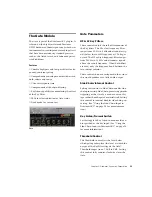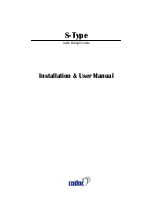
Chapter 3: Drawmer Dynamics Parameters
21
Attack Times
The longer the attack time, the longer the Com-
pressor takes to respond to increases in signal
level and a slow attack time is often used to ac-
centuate the beginning of percussive or plucked
sounds such as drums, basses and guitars. a long
attack time can also permit peaks to pass unat-
tenuated. The limiter will pick these up, so it is
quite common with slow attack times to see in-
creased limiter activity. A fast attack time will
bring the input signal under control very
quickly.
Pumping
Pumping
refers to heavy compression with incor-
rectly set envelope parameters. This results in
very audible gain changes when the compressor
attacks and releases. It is often an indication
that the release time is too long. Release time
should be set short enough so that the gain has
returned to normal before the next signal peak
occurs, and, in general, it should be set as short
as possible before audible gain pumping occurs.
In most cases, an output of 0 dBfs is the opti-
mum output level. Lower output levels can be
set using the Limiter Threshold. You might want
to do this so that later inserts can better receive
an optimized signal level at their input. If so, set
the Peak Limiter Level to the desired output
value then adjust the Compressor Auto or man-
ual Gain control to ensure minimum Limiter ac-
tivity.
Peak Limiter Bypass
The Peak Limiter has no bypass control. How-
ever, turning the Level control fully clockwise
will prevent virtually all limiting. To use the
Limiter while effectively bypassing the Com-
pressor, turn the Compressor Threshold fully
counter clockwise to its maximum of +0 dB.
Then set the Ratio to its lowest setting of 1.1:1 if
Gain Make-Up is set to manual. Set the Gain to
0 dB if Auto Gain is enabled.
Compensating for Apparent Dullness in
Compressed Material
Compression can sometimes seem to have the
effect of dulling audio material. Most of the en-
ergy in typical broadband music is contained
within the bass range. This high energy causes
the Compressor to operate, causing any quieter,
high frequency sounds occurring at the same
time to be reduced in level. That is why the cym-
bals and hi-hats in a heavily compressed drum
track seem to dip in level whenever a loud bass
drum or snare drum beat occurs.
The solution is to use less compression or in-
crease the attack time to allow the leading edge
of the brighter sounds to pass through the Com-
pressor before gain reduction occurs. Though
the semi-soft-knee compression systems used in
Drawmer Dynamics modules tend to minimize
this effect, in extreme cases, it may be necessary
to add a little artificial brightness to the pro-
cessed sound using equalization or some form of
exciter.
The Limiter
If the Compressor module is used with higher
ratios, it will function as a Limiter. In addition
to this feature, there is a separate auto-adaptive
Peak Limiter. This not only catches any peaks
that a slow Compressor attack might pass
through unprocessed, but also lets the user set
an absolute output signal level that will not be
exceeded.
Summary of Contents for Drawmer Dynamics
Page 1: ...Drawmer Dynamics Version 7 0 ...
Page 8: ...Drawmer Dynamics Plug Ins Guide 4 ...
Page 12: ...Drawmer Dynamics Plug Ins Guide 8 ...
Page 30: ...Drawmer Dynamics Plug Ins Guide 26 ...
Page 39: ......















































